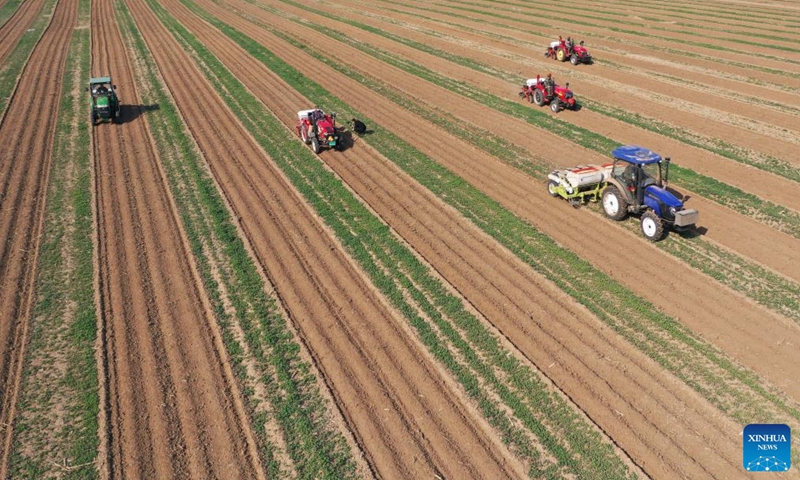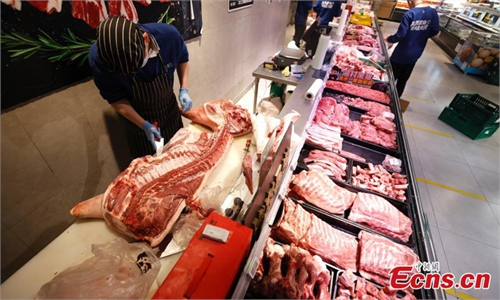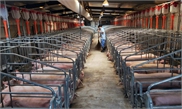
Aerial photo taken on May 11, 2022 shows farmers operating machines to sow soybean seeds in Fanhe Township of Tieling, northeast China's Liaoning Province. Liaoning has stepped up efforts on farming activities as the temperature rises recently. By May 17, the province's spring sowing area of crops has reached 48,645,000 mu (3,243,000 hectares).(Photo: Xinhua)
Major Chinese hog farmers and feedstock producers on Tuesday explained their efforts to cut down soybean meal use in a bid to lower the country's dependence on the crop and ensure the nation's food security.
Muyuan Foods Co, a leading hog and pork producer, said the company saved 1.3 million tons of soybean meal compared with the average level by using just 6.9 percent of soybean meal in its compound feed for pig breeding in 2021.
New Hope Liuhe, China's major feedstock producer, said it used just 10.7 percent soybean meal in its feed products in 2021, about 4.6 percentage points lower than the industry average, equivalent to reducing soybean meal consumption by 1.3 million tons.
The examples were cited after the Ministry of Agriculture and Rural Affairs (MOA) on Monday which vowed to comprehensively reduce the use of soybean meal in feed amid efforts to ensure national food security.
The MOA pointed out that the reduction is aimed at ensuring China's food security amid uncertain external supplies and promoting high-quality development and efficiency of the industry.
China has been highly reliant on soybean imports, driven up by the demand for livestock feed, which makes it a key agricultural product for China's food security, experts said.
Wang Zuli, deputy researcher at the Institute of Agricultural Economics and Development of the Chinese Academy of Agricultural Sciences, said the move is aimed at reducing dependence on soybean imports, which are heavily driven by demand for soybean meal.
"With the complicated international trade situation and the uncertainty of international trade relations, reducing import dependence is conducive to ensuring food security," Wang told the Global Times on Tuesday.
Research from Guolian Securities pointed out that in 2021, total domestic consumption of soybean meal reached 78.4 million tons, an increase of 2.8 percent year-on-year, much of which was used for feed.
MOA officials said in February that if effective policies and measures were put in place, soybean meal production could be reduced by more than 23 million tons, and reduce soybean demand by nearly 30 million tons, equivalent to soybean output of 230 million mu (15.33 million hectares) of farmland.
The ministry has promoted the reduction of soy use in animal feed in recent years, which has had a positive effect.
In 2021, soybean meal accounted for 15.3 percent of the feed consumed by the aquaculture industry in China, 2.5 percentage points lower than in 2017. That decline saved 11 million tons of soybean meal, which was equivalent to 14 million tons of soybeans and the output of more than 100 million mu of farmland, the MOA said.
Chinese companies have also been promoting a low-protein diet as a replacement for soy meal.
Muyuan Foods Co said that by adding appropriate amounts of five or six synthetic amino acids, it can reduce the standard of feed protein content in the whole process of pig breeding to 12 percent. This process can greatly reduce the use of soybean meal and other protein raw materials.
Imported soybeans account for 85.5 percent of domestic demand, according to the country's customs data.
Brazil is China's largest source of imported soybeans, followed by the US. In 2021, China's soybean imports from Brazil reached 58.15 million tons, accounting for about 60.2 percent of total soybean imports. Imports from the US stood at 32.31 million tons, about 33.5 percent of the total.
In 2021, China imported 96.51 million tons of soybeans, down 3.8 percent year-on-year.
Global Times



